Self-Blend model은 전통적인 교육과정을 보충하기 위해 하나 이상의 수업을 온라인 수업으로 완전히 대체할 수 있는 교수학습 시나리오이다. 그리고 미리 녹음/녹화된 자료들은 교사 역할을 하며 온라인 학습을 가능하게 한다. 학생들은 이러한 온라인 과정을 학교에서 듣거나 학교 이외의 장소에서 들을 수 있다.
Self-Blend model은 Full-time online learning과 Enriched-Virtual model 과는 다르다. 왜냐하면 이 두 모델은 학교에서 이루어지는 정규과정이 아니기 때문이다. Self-Blend model에서 학생들은 자신이 학습방법을 결정하여 어떤 과정은 온라인으로 듣고 다른 과정은 교사와 대면하면서 학교에서 수업을 들을 수 있다.
위의 그림에서 볼 수 있듯이 수업방법은 크게 온라인과 오프라인으로 나누어져서 진행되며 학습장소는 학교와 집으로 나뉠 수 있다. 학생은 온라인 수업을 학교와 가정에서 실시할 수 있으며 자신이 판단하여 동일한 과정을 학교에서 오프라인으로 교사와 대면하여 들을 수 있다. 또한 온라인 티처들이 있어서 학생의 학습을 도와주고 있다.
Sunday, April 27, 2014
Monday, March 31, 2014
Blended Learning - Flex Model
Flex model은 Rotation model과 동일하게 학습 내용과 지도는 주로 인터넷으로 전달된다. 하지만 학생들은 Rotation model과는 다르게 Flex model에서는 개인의 요구에 맞춘 가변적인 스케쥴대로 움직인다. 그리고 학생들을 도와줄 수 있는 보조교사(teacher-of-record)들이 대기하고 있다. 이러한 보조교사들은 상황에 따라서 유동적이거나 상황에 대처하여 소그룹지도, 그룹프로젝트, 개인지도 등의 활동을 통하여 학생과 대면하여 도움을 주기도 한다.
Flex model 유형 중 몇몇 활동들은 직접적으로 대면하여 도움을 주기도 하지만 다른 활동들은 최소한의 도움만을 준다. 이처럼 학생들을 지원하는 교사들의 운용의 여러 조합들은 Flex model만의 고유한 특징이다.
위의 그림을 잠시 살펴보자면 breakout room은 토의실이며 다양한 토의 규모를 지원하고 있다. 또한 study and collaborative space 에서는 개인의 요구에 맞춘 가변적 스케쥴에 따라서 학습 내용을 습득하는 공간이다.
결론적으로 Flex model은 학생의 요구에 맞추어 오프라인 교육과 온라인 교육이 다양한 협업/협동 형태로 동시에 일어나는 모델이며 이 모델에서는 학생들이 교사 및 보조교사(paraprofessional)을 통하여 도움을 받을 수 있다.
Sunday, March 16, 2014
Blended Learning - Rotation Model
Rotation model은 Station-Rotation model, Lab-Rotation model, Flipped-Classroom model 그리고 Individual-Rotational model 등으로 네 가지의 유형이 있다. Rotation model에서 학생들은 고정된 스케쥴이나 교사가 정한대로 돌아가면서 수업에 참여한다. 이 때 학생들이 참여하는 수업은 최소한 하나 이상이 온라인 수업이어야 한다. 수업 방식은 여러 활동들을 포함하는데, 소집단이나 전체집단 강의, 그룹 프로젝트, 개인 교습, 그리고 지필 과제 등이 포함된다.
A. Station Rotation
한 과목이나 과정에서 Station Rotation 모델을 실행할 때 학생들은 고정된 수업 흐름을 따르거나 교사가 정한 수업 흐름대로 진행한다. 이 모델이 Individual-Rotation model과 다른 점은 Individual-Rotation model에서는 학생들이 자신이 정한 방법대로 진행할 수 있지만 Station Rotation model에서는 학생들은 모든 station을 다 돌아야 한다.
B. Lab-Rotation
Lab-Rotation model은 다른 Rotation model과 비슷하나 Station-Rotation model과 다른 점은 Station-Rotation model에서 학생들은 한 교실 안에서만 머물러 있으나 Lab-Rotation model에서 학생들은 학교 여기저기를 돌아다닐 수 있다.
C. Flipped Classroom
Flipped Classroom은 수업의 내용과 지도가 학생에게 온라인으로 먼저 전달이 된다. 이는 Flipped Classroom이 단순히 숙제를 온라인으로 하는 것과는 다르다. 그리고 이 모델은 블렌디드 러닝의 '학생이 시간, 장소, 방법 그리고 진도에 대해 주도권을 가진다'라는 개념과 일치한다. 왜냐하면 이 모델은 학생들에게 어디서 수업의 내용과 지도를 받을 것인지 그리고 진도를 어떻게 나갈 것인지에 대한 주도권을 주기 때문이다.
D. Individua Rotation
Individual Rotation 모델은 다른 Rotation model과 비슷하나 다른점은 이 모델에서는 학생들이 각각의 station이나 활동들을 다 참여할 필요가 없다. (즉, 자신이 Rotation 방식을 정하는 모델이다.)
다음은 Flex model에 대해서 살펴보도록 하겠다.
Opinion - The Ultimate Goal of Smart Learning - II
Several days ago, a parent visited me and consulted with me about her worries of using smartphones for studying and she talked about how bad the effects of using smart gadgets on students are. Her claim is that using smart gadgets easily distracts students' attention; if students look at a tiny little screen for a long time, it would injure their eyesight; students tend to get addicted to games while using gadgets; and finally gadgets emits harmful electromagnetic waves to students.
If you were me, what kind of answers would you give to her? Would you emphasize on the striking development in smart technologies or on the world's trend on e-learning? The parent's claim is plainly based on miscomprehension about Smart learning and seems quite out-dated.
However, before criticizing her misconception on using smart gadgets as a stupid reaction, let's consider hers as a it-might-happen case when the goal of smart learning is not fully understood by students or parents: users.
In the last posting, I compared two kinds of drawings: a drawing by hands and a drawing by smart gadgets. And talked about the sad situation in which we are forced to be and have to be always smartish when it comes to doing smart learning.
Using ICT in education became a household name in everywhere regardless of age or gender. And we see it as one of fairly effective and adequate means to educate, manage and produce something or someone. In regard to using ICT, especially in education, we might tend to think of fancy electronic gadgets and fascinating technologies and have a high possibility to blindly worship its complicatedness and showy features without educational perspectives.
ICT itself doesn't indicate who, when, where, what, how and why teacher should use in class even though new ones are already overflowing in class. In other words, smart gadgets held in students' hands don't guarantee quality education. Unless a firm foundation of educational philosophy and methodology is predetermined, confusion in class is to be crystal-clear.
If you were me, what kind of answers would you give to her? Would you emphasize on the striking development in smart technologies or on the world's trend on e-learning? The parent's claim is plainly based on miscomprehension about Smart learning and seems quite out-dated.
However, before criticizing her misconception on using smart gadgets as a stupid reaction, let's consider hers as a it-might-happen case when the goal of smart learning is not fully understood by students or parents: users.
In the last posting, I compared two kinds of drawings: a drawing by hands and a drawing by smart gadgets. And talked about the sad situation in which we are forced to be and have to be always smartish when it comes to doing smart learning.
Using ICT in education became a household name in everywhere regardless of age or gender. And we see it as one of fairly effective and adequate means to educate, manage and produce something or someone. In regard to using ICT, especially in education, we might tend to think of fancy electronic gadgets and fascinating technologies and have a high possibility to blindly worship its complicatedness and showy features without educational perspectives.
ICT itself doesn't indicate who, when, where, what, how and why teacher should use in class even though new ones are already overflowing in class. In other words, smart gadgets held in students' hands don't guarantee quality education. Unless a firm foundation of educational philosophy and methodology is predetermined, confusion in class is to be crystal-clear.
Then, what kind of philosophy or methodology must be settled?
Will continue soon.
Wednesday, March 12, 2014
Opinion - The Ultimate Goal of Smart Learning - I
One of my favorite TV channels is Kings of Restoration on History HD Channel. The reason why I love this channel is I can get a glimpse of the culture how much americans love their old memorabilia. I can see how much they cherish their old memories still existing in the small and tiny trivial things. Even though there are many glittering newest motorcycles, they bring out rusted and dirty ones out of the garage to get restored as it was into fashion. I have seen many things restored not only big things but small and worthless things such as an old taxi meter which his father left.
This trend is so surprising to me because they honor their traces in the past and want to keep their memories in the old time living in one of the most developed countries. Compared to the states, South Korea, where the government pushes people to follow and adapt what is the newest but less emphasizes on what is old-time. Should we abolish and ignore old-fashioned ones to develop and move forward?
Smart Education is in season nowadays. In Korea, most of educational drives are connected to Smart Education. Somehow, in a skeptical stance, it seems a little bit frantic and blind to follow the trend. For example, we don't think it is not Smartish when we just draw things on a canvas. But it is thought to be Smartish when someone draws things using smart gadgets and share with others on the internet. If you have tried to have students draw using smart gadgets, you would probably have felt that the quality of drawing must have been gone off because it is not fully optimized in drawing compared to drawing with hands.
However, when you ask the same students to draw using analog tools such as pencils, brushes, etc, soon you will be astonished by how you ignore their creativity and diversity and didn't understand their potentials which were not revealed in a smart world.
How much the drawings become detailed and elaborate!
Will continue soon!
This trend is so surprising to me because they honor their traces in the past and want to keep their memories in the old time living in one of the most developed countries. Compared to the states, South Korea, where the government pushes people to follow and adapt what is the newest but less emphasizes on what is old-time. Should we abolish and ignore old-fashioned ones to develop and move forward?
 |
| Dog with iPad - 6 grader's drawing |
 |
| Dog with iPad- 6 grader's drawing |
However, when you ask the same students to draw using analog tools such as pencils, brushes, etc, soon you will be astonished by how you ignore their creativity and diversity and didn't understand their potentials which were not revealed in a smart world.
 |
| Sketch with pencil |
 |
Sketch with pencil
|
Will continue soon!
Sunday, March 9, 2014
Collaboration in Making Bulletin Board - I
To start my new semester with my 6 graders, I set up my mind to apply Blended Learning to the class. The emphasis of Blended Learning is on setting an online learning environment where they can share, create, verify and assess their own ideas in addition to an offline learning environment. One of the perks they can enjoy online compared to offline learning is they are not bound to time, path and place but free to do anything they couldn't do in a brick-and-mortar environment.
Anyways, out of many useful and helpful sites, for example, Wedorang, Facebook, Google+ and Classting, I found Classting to be most applicable because of its convenience in joining the site: no age limit, no complicated admission process and user friendly and intuitive menus.
To break the ice and let students know each other in a short time, I thought pushing them into a world of collaboration might work so I started from a small thing: Making a Bulletin Board.
First, I asked their thought on making a bulletin board in class using Classting. Students shared their ideas on it and some students uploaded some examples to make it clear.
After collecting general thoughts on making a bulletin board, I categorized the thoughts and systemized them using OKmindmap with students. After discussing on what to do, they were assigned to each part.
As of now, Mar, 9, students are sharing their ideas in group on the site
Will continue soon.
Introduction to Blended Learning
요즈음 교육현장은 오프라인 수업과 온라인 수업이 공존하여 새로운 생태를 만들어내고 있다. 특히 거꾸로 교실(Flipped Learning)이라든지 위두랑이나 클래스팅을 이용하여 수업이 일어나는 현장을 학교 내에서 뿐만 아니라 시간과 장소에 구애받지 않고 확장되었다. 이러한 수업의 종류는 다음과 같이 분류할 수 있다.
[그림1] 온오프라인 교육의 유형, 출처 : Classifying K–12 Blended learning (Innosight Institute)
[그림2] Blended Learning의 정의, 출처 : Classifying K–12 Blended learning (Innosight Institute)
그러므로 [그림1]과 같이 정규교육과정을 벗어난 온라인 교육이라든지 정규과정 중에 오프라인 수업만 있는 교육은 엄밀히 말해서 Blended Learning이라고 할 수 없고 Blended Learning의 범주에서 벗어난다.
그러면 Blended Learning의 유형은 어떤 것이 있을까? 위의 정의에서 살펴볼 수 있듯이 Blended Learing은 오프라인교육과 온라인교육의 조합으로 이루어져 있으며 두 개의 요소 중 한 요소가 제외될 수 없다. 다음은 Blended Learning의 네 가지 유형이다.
[그림3] Blended Learning의 유형, 출처 : Classifying K–12 Blended learning (Innosight Institute)
위에서 볼 수 있듯이 Blended Learning은 Rotation Model, Flex Model, Self-Blend Model, Enriched-Virtual Model 등 총 네 가지로 이루어져 있다. 특징은 1번에서 4번으로 갈 수록 온라인 교육의 비중이 커진다는 것이며 또한 교육과정에 대한 학생의 자율권이 커진다는 것이다.
(요즈음 한국에서는 Rotation Model의 하위 영역인 Flipped Learning에 상당한 관심을 가지고 심도있게 연구가 진행되고 있다. 개인적인 의견으로는 네 가지 영역에 대한 균형잡힌 접근이 필요할 것 같다.)
다음 Post에서는 각 영역에 대해 자세히 알아보도록 하겠다.
Monday, March 3, 2014
Wedorang과 함께 자기소개 하기
2014학년도 새학기가 시작되었습니다. 오늘 새롭게 만날 아이들을 생각하니 설레기도 하고 기대가 됩니다. 새학기가 시작되면 빼놓을 수 없는 것이 바로 자기소개인데요. 이번에는 자기소개를 위두랑의 과제 기능을 활용할 예정입니다.
Sunday, March 2, 2014
Wedorang 가입하기
2014년 부터 적용되는 디지털 교과서의 효과적인 사용을 위해서 위두랑을 가입하는 방법에 대해서 알아보겠습니다. 순서대로 따라해보세요.
1. 회원가입
스마트교육 웹사이트의 회원가입을 클릭하여 회원가입 화면으로 이동합니다.
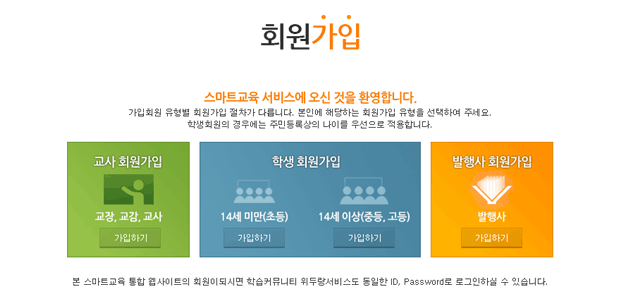
- 1) 본인의 회원유형을 선택합니다.
- 2) 초등학생은 14세미만 회원가입을 이용합니다.
- 3) 중.고등학생은 14세이상 회원가입을 이용합니다.
- 4) 교사는 교사회원 가입을 이용합니다.
2. 약관동의
모든 약관을 확인해보시고 약관을 동의해주셔야 합니다.
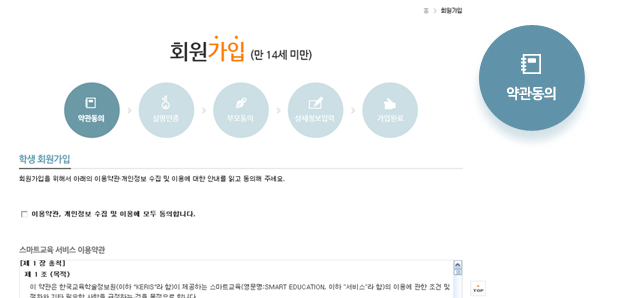
3. 실명인증
학생회원은 i-PIN / 주민등록번호를 통해서 교사는 공인인증서를 통해서 본인 실명을 하게 됩니다.
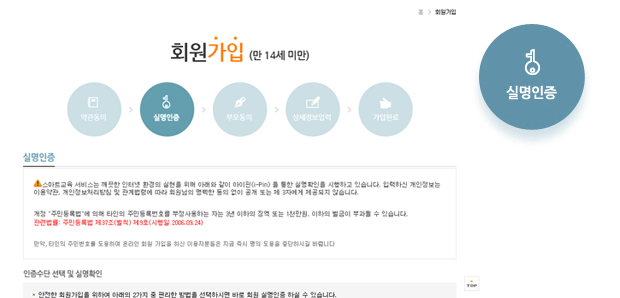
4. 부모동의
만14세 미만의 회원가입 시에만 필요합니다.
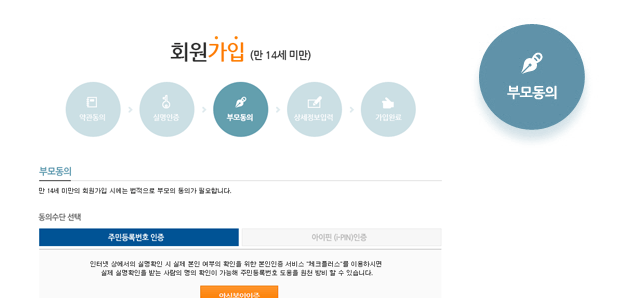 1) 부모 동의할 수 있는 유형을 선택해서 부모동의 절차를 진행해주세요. (주민등록번호 인증, 아이핀 인증)
1) 부모 동의할 수 있는 유형을 선택해서 부모동의 절차를 진행해주세요. (주민등록번호 인증, 아이핀 인증)
2) 부모님의 주민등록번호를 미리 알아오는 것이 좋습니다.5. 회원가입
다음과 같은 항목을 정확히 기입해주세요.
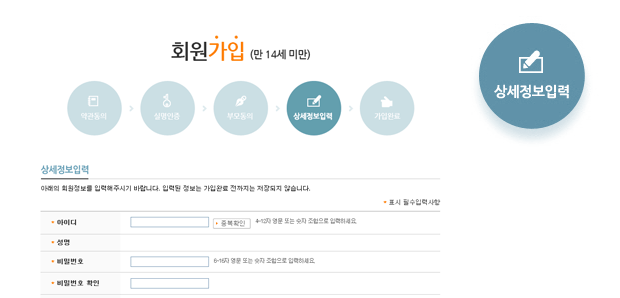 1) 학생일 경우 위와 같은 화면에 필요한 항목을 모두 입력해주세요.
1) 학생일 경우 위와 같은 화면에 필요한 항목을 모두 입력해주세요.6. 회원가입완료
모든 회원가입 절차를 완료하였습니다.
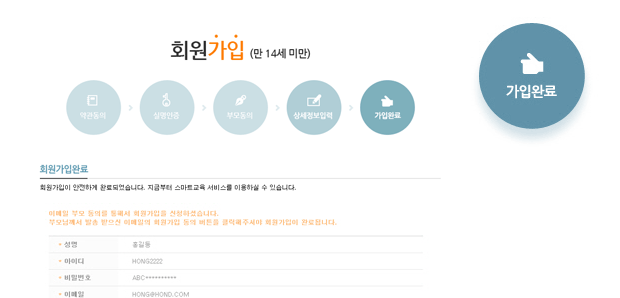
Subscribe to:
Posts (Atom)




















